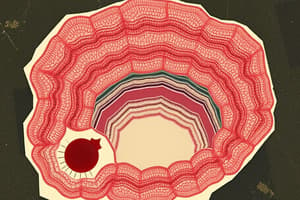Podcast
Questions and Answers
What is the definition of epithelia?
What is the definition of epithelia?
- Cells that only provide protection.
- A type of muscle tissue.
- Classified based on the number of cell layers and cell shape. (correct)
- Only present in the skin.
What is simple epithelia?
What is simple epithelia?
Has one layer of cells.
What is stratified epithelia?
What is stratified epithelia?
Has more than one layer of cells.
Describe squamous cells.
Describe squamous cells.
What are cuboidal cells?
What are cuboidal cells?
What are columnar cells?
What are columnar cells?
What is simple squamous tissue?
What is simple squamous tissue?
What is simple cuboidal tissue?
What is simple cuboidal tissue?
What does simple columnar tissue do?
What does simple columnar tissue do?
What is stratified squamous tissue?
What is stratified squamous tissue?
What is stratified columnar tissue?
What is stratified columnar tissue?
What is pseudostratified columnar tissue?
What is pseudostratified columnar tissue?
What type of epithelial tissue appears cuboidal when not stretched?
What type of epithelial tissue appears cuboidal when not stretched?
The two types of cell layers are ____ and ____.
The two types of cell layers are ____ and ____.
Name the five types of epithelial tissue that describe cell shape.
Name the five types of epithelial tissue that describe cell shape.
There are eight types of epithelial tissues.
There are eight types of epithelial tissues.
Flashcards are hidden until you start studying
Study Notes
Epithelial Tissue Basics
- Epithelia are classified by cell layers and shape: first name denotes cell layers, second denotes cell shape.
Types of Epithelia
- Simple epithelia: Composed of a single layer of cells.
- Stratified epithelia: Composed of multiple layers of cells.
Cell Shapes
- Squamous cells: Flat in shape, facilitating diffusion.
- Cuboidal cells: Cube-shaped, primarily involved in secretion and absorption.
- Columnar cells: Taller than wide, involved in secretion and absorption processes.
Specific Epithelial Types
-
Simple Squamous:
- Thin, flat cells in a single layer.
- Functions: diffusion, filtration, some secretion.
- Locations: lining of blood vessels, heart, lymphatic vessels.
-
Simple Cuboidal:
- Single layer of cube-shaped cells.
- Functions: active transport, secretion, and diffusion.
- Locations: kidney tubules, glands, and ducts.
-
Simple Columnar:
- Single layer of tall, narrow cells.
- Functions: movement of particles (e.g., in bronchioles).
- Locations: glands and some ducts.
-
Stratified Squamous:
- Multiple layers; basal cells are cuboidal or columnar, flattening at the surface.
- Functions: protection against abrasion, infection barrier.
- Location: outer layer of skin.
-
Stratified Columnar:
- Multiple layers with only surface cells being columnar; deeper cells are cuboidal.
-
Pseudostratified Columnar:
- Appears stratified but consists of a single layer where not all cells reach the apical surface.
- Functions: typically involved in secretion and movement of mucus.
-
Transitional:
- Stratified tissue that appears cuboidal when unstretched and squamous when stretched.
- Location: lining of the urinary bladder.
Cell Layer Classifications
- Simple: One layer of cells.
- Stratified: More than one layer of cells.
Cell Shape Classifications
- Squamous: Wider than tall (plate-like).
- Cuboidal: Equal height and width (cube-like).
- Columnar: Taller than wide (column-like).
- Transitional: Unique ability to change shape.
- Pseudostratified: Appears layered but is a single layer with varying cell heights.
Studying That Suits You
Use AI to generate personalized quizzes and flashcards to suit your learning preferences.




